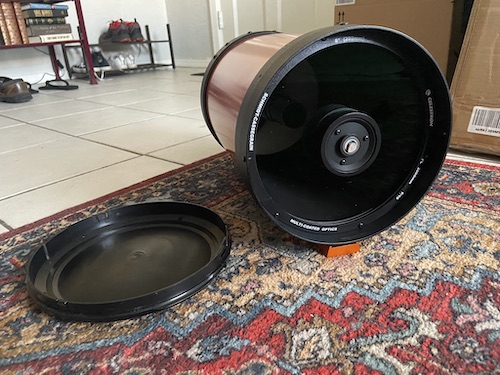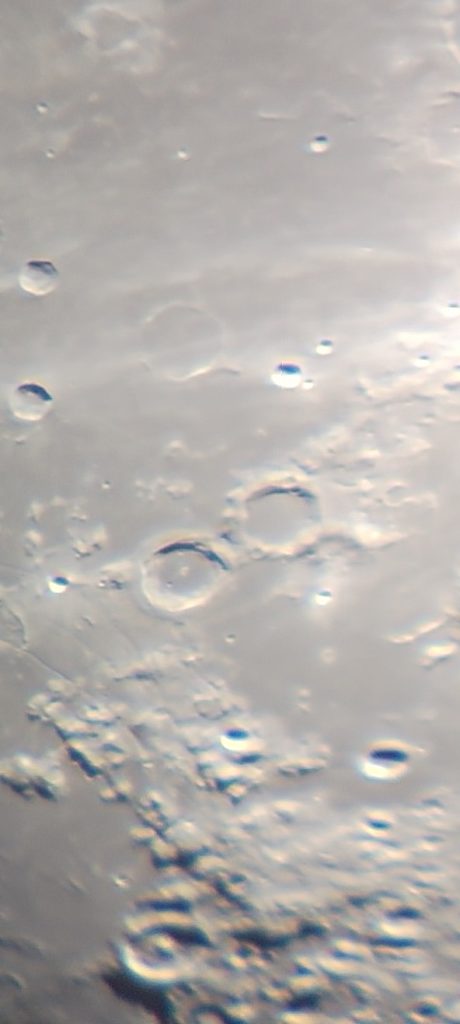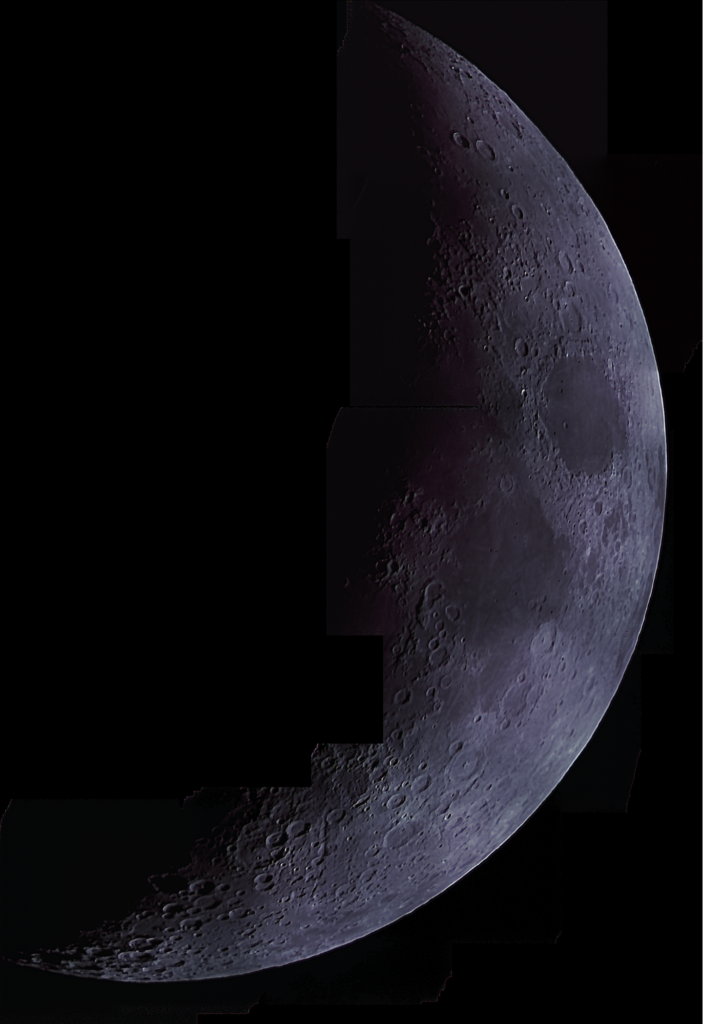Celestron’s C8 is the oldest telescope that is still in mass production, the oldest Celestron’s telescope still in production, the second-oldest telescope still in production overall (after the Questar), and arguably one of if not the most popular amateur telescopes sold of all time. That’s already a pretty impressive resume, isn’t it? The C8 can be used for visual astronomy and astrophotography of all types and is compatible with an impressive array of accessories.
I myself have owned no fewer than a dozen C8s as of the time of the latest revision (late August 2019) and currently own one of the first few hundred to roll off the assembly line in the early 1970s. That is how much I love these scopes.
A Brief History of the C8

Celestron’s founder, Tom Johnson, invented a way to mass-produce Schmidt corrector plates and Schmidt-Cassegrain telescopes around 1963, with Celestron marketing its debut C22, a 22” Schmidt-Cassegrain designed for observatory use, soon after in early 1964. 16”, 12”, 10”, 8”, 6”, and 4” models soon followed with the 10” C10 being the most popular with a few hundred made total, and overall maybe a thousand of these early blue-and-white scopes were manufactured in total from 1964 to 1972, when they were discontinued.
The original, blue-and-white C8, sold at f/12 and f/17 focal ratios, was the second-least popular telescope in Celestron’s lineup, only behind the C12, simply because for not much more money you could upgrade to a C10 and both were extremely expensive in the first place.
In 1970 Celestron devised a less expensive C8 model with an orange tube and brown and gray fork mounting, and an f/10 focal ratio. At a total weight of fewer than 50 pounds, the C8 weighed about half as much as the only other options for an 8” telescope at the time, 8” f/7 or longer Newtonian reflectors on massive steel equatorial mounts. Not only that, but the C8 could fit in virtually any vehicle – unlike a massive, long equatorial Newtonian which cannot easily fit in most cars. It sold for £1200 at the time with the fork mount and no tripod included. For thirty years there was always a C8 available with a fork mount and no tripod at right around this price if not lower, despite inflation. Today’s NexStar 8SE, Celestron’s least-expensive complete 8” SCT package, runs only a couple hundred dollars over that and includes GoTo and far better optical coatings, the latter of which we will talk about later.
After a few years, Celestron switched to gray paint for the forks, then die-case construction for the mount and tripod instead of more expensive sand-casting. In 1983 came the Super C8 with an all-black finish and improved drive systems. For about twenty years after, Celestron continued selling more or less the same telescope repackaged on different mount/drive systems. In the mid-2000s Celestron was bought by Synta Optical Technologies (which also owns Sky-Watcher and manufactures parts for Meade, Orion, and others) and production moved to China.
Today’s C8 still has a lot in common with a 1970s Orange Tube, but the scopes are made and tested in a different facility on the opposite side of the planet. The same C8 XLT scope reviewed here is identical to the 8” f/10 optical tube sold with all of Celestron’s NexStar, CPC, and various equatorially-mounted telescopes. Celestron also sells a more advanced “EdgeHD” 8” f/10 with various small corrector lenses mounted in the baffle tube to increase edge-of-field sharpness for astrophotography.
Overview Of X8 XLT
As a Schmidt-Cassegrain, the C8 utilises a catadioptric 3-element design with a Schmidt corrector plate at the front, a spherical primary mirror, and a slightly aspheric hand-figured secondary mirror. The Schmidt corrector is not a flat piece of glass as some believe, but a precision 4th-order curved optical surface made in a special “master block” process – replacing it with flat glass will result in severe spherical and other aberrations. If you break the corrector, the scope’s entire set of optics must be replaced as the secondary mirror is hand-figured to match a particular corrector’s exact optical prescription.
Like all Celestron SCTs ever manufactured, the C8 uses a moving-mirror focusing system with the primary sliding back and forth on a threaded rod. As this configuration is asymmetrical, the primary mirror can flop around while focusing, causing image shift, and over long periods while imaging can slowly flop causing mirror flop, which ruins an exposure. Thankfully, with the modern C8 XLT, this problem has been all but banished. If you plan on doing long-exposure astrophotography with the C8, you can add aftermarket mirror locks to solve this or buy the EdgeHD model which comes with them.
The StarBright XLT multi-coatings on the newer C8s result in higher light transmission than with older scopes – the scope only loses about 2.6% of the light hitting it to reflections off the corrector and absorption through the mirrors. Supposedly an older-generation C8 with no corrector coatings and standard mirror coatings loses a massive 27% of the light entering it, and a C8 with regular “Starbright” or “Special Coatings” loses 13%. I would not read too much into these numbers. Even if they are true, the human eye is not very good at detecting the difference at the eyepiece and while Starbright may make images a little brighter it is probably not going to make the difference between seeing a faint object or not. Still, it is nice to have.
Like all SCTs, the C8 uses standard threads on its back allowing for the attachment of:
- An f/6.3 reducer/corrector, which itself has SCT threads on its back to attach anything else to
- A camera T-adapter
- An off-axis guider for autoguiding
- A 1.25” or 2” visual back
- A 2” thread-on star diagonal
- A Crayford focuser to fine-tune your focus for Astro-imaging and avoid mirror flop
As well as various other, more specialty accessories.
The optics in most C8s are very sharp. Magnifications of up to 400x are possible on good nights. Deep-sky objects are plenty of fun with 8” of aperture, and you can see a wealth of detail on the Moon and planets. I had one really good C8 that was able to show albedo features on Jupiter’s moons!
The only major con of this scope is its relatively slow focal ratio of f/10 and resulting narrow field. The maximum field of view you can get without vignetting is about 1.35 degrees using either a wide-field 2” eyepiece or a 1.25” eyepiece with the scope’s f/6.3 reducer. This means some deep-sky objects will not fit in the field.
The C8 XLT comes with a decent 1.25” visual back and a usable, albeit small, 6×30 finderscope. If you are planning on visual use, a Telrad and/or 9×50 in place of the 6×30 finder would be good, as well as a 2” star diagonal and/or f/6.3 reducer.
Astrophotography capabilities
You can do deep-sky astrophotography with your C8 on a mount with at least 40 pounds of capacity like a Celestron CGEM, Sky-Watcher EQ6, Orion Atlas, or Losmandy G11. I would probably recommend using the f/6.3 reducer, and you should definitely use autoguiding.
For planetary imaging, pretty much any steady mount with a drive, be it a NexStar mount, a clock-driven fork mount, or an EQ5-class equatorial mount will do the job. A good 2x Barlow lens and a camera like the ZWO ASI120MC would be the ideal minimum setup.
The following pictures barely scratch the surface of what is possible with a C8 and were all taken by me with a 640×480 CCD camera or a phone held up to the eyepiece:






Conclusion
The Celestron C8 is one of the most popular, versatile telescopes ever made. If you are looking to do anything other than wide-field viewing or imaging of deep-sky objects, it’s hard not to want one.
